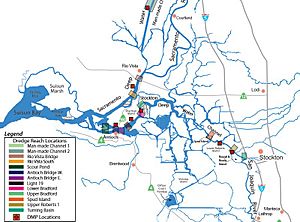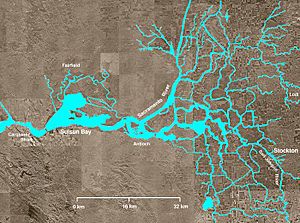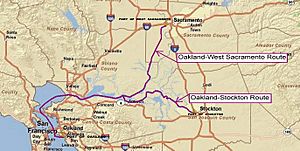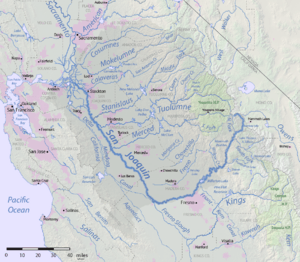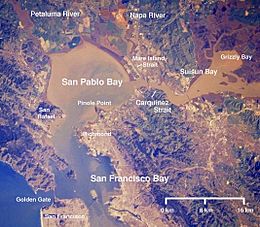Stockton Deepwater Shipping Channel facts for kids
Stockton Deepwater Shipping Channel is a special, man-made water path for big ships in California. It's also known as the Baldwin-Stockton Deepwater Shipping Channel or Stockton Deep Water Channel. This channel connects Suisun Bay and the Sacramento River to the Port of Stockton and the Stockton Channel.
The channel is about 41 miles (66 km) long and 37 feet (11 m) deep. This depth allows large ocean ships, even those as big as the ones that use the Panama Canal, to reach the Port of Stockton in the City of Stockton. The Stockton Deepwater Shipping Channel is part of the huge Sacramento–San Joaquin River Delta, which eventually connects to the Pacific Ocean. Sometimes, people also call it the lower San Joaquin River.
Contents
Why the Channel Was Built
Back in 1849, during the California Gold Rush, steamboats could travel far up the San Joaquin River. But as farming grew in the San Joaquin Valley, more river water was used for crops. This made the river shallower. Slower water also meant more dirt and mud (called silt) built up, making the river even shallower.
By 1890, the city of Stockton was no longer an important seaport. Ships couldn't easily reach it anymore. In 1910, people in Stockton started making plans to dig out the river to make it deeper. This process is called dredging. However, these plans were put on hold because of World War I.
In 1925, the city of Stockton raised $1.3 million to start the dredging project. Then, in 1926, Stockton teamed up with the federal and state governments. Together, they created an $8.2 million fund to change the river into a new channel.
Building the Deepwater Channel
The big river-channel project started in 1928. Workers made the river both wider and deeper. To make the path straighter for ships, they removed curvy parts of the river called meanders and old river bends called oxbow lakes.
Major straight cuts were made at places like Hog Island, Venice Island, and Mandeville Island. Five smaller cuts were also made. The new deepwater channel became 41 miles (66 km) long and 37 feet (11 m) deep.
Even after all this work, silt still builds up. So, more major dredging was done in 1968 and 1982 to keep the channel deep enough. Today, the Stockton Deep Water Ship Channel can handle very large ocean vessels. These ships can weigh up to 60,000 short tons (54,431,084 kg) and be up to 900 feet (274 m) long!
Environmental Concerns
Making the river-channel straighter and slower had an unexpected side effect. It caused the amount of oxygen dissolved in the water to become very low in the lower San Joaquin River.
Low dissolved oxygen is a problem because it harms the fish populations living in the river. There are three main reasons for this issue:
- The river was straightened, which changed its natural flow.
- Pollution from harbors and cities also affects water quality.
- Poor mixing of the water from tides makes the problem worse.
Baldwin Deepwater Shipping Channel
The Baldwin Deepwater Shipping Channel, also known as the John F. Baldwin Shipping Channel, is another important water path. It runs from the San Francisco Bay through the San Pablo Bay and Suisun Bay to where the Stockton Ship Channel begins.
The Baldwin Deepwater Shipping Channel is kept at a maximum depth of 45 feet (14 m) and is usually maintained at 35 feet (11 m) deep. It is 600 feet (183 m) wide. This channel is named after John F. Baldwin Jr., who was an American military officer and later a U.S. Representative from California. The Carquinez Strait is part of the John F. Baldwin Shipping Channel.
Places Along the Stockton Deepwater Shipping Channel
Many important places are located along the Stockton Deepwater Shipping Channel, including:
- Suisun Bay
- Sacramento River
- City of Antioch
- Antioch Bridge
- Sherman Island
- Jersey Island
- Mokelumne River
- Bouldin Island
- Old River
- Mandeville Island
- Venice Island
- Port of Stockton
- Stockton Channel
- City of Stockton
- Upper San Joaquin River


